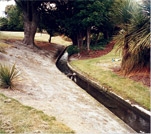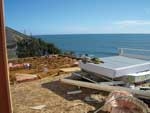PDF of this article (120 KB)


Sitting astride a tectonic plate boundary in the Southern Ocean’s ‘roaring forties’, New Zealand is exposed to a wide range of geological and weather-driven hazards. Events such as storms, floods, and coastal inundation directly affect people, property, and economic activities, and we’re all affected indirectly when insurance rates rise to spread the risk. NIWA’s hazards research aims to understand which parts of New Zealand are most at risk, predict the likely impacts, and to help devise ways to reduce the risk though future planning, hazard forecasts, and response during emergencies.
The basis for evaluating hazard risk is good knowledge of past events so the probability of future events can be estimated. For example, the probability of occurrence of floods, wind storms, or tornadoes of a given size is often expressed as a return period. Knowing the likelihood of hazards allows for planning and design to take them into account and keep development and human activities out of harm’s way, for example coastal subdivision and flood plain development. Weather-driven hazards are subject to climate change effects that need to be taken into account. There is also a need to understand the processes, for example, how a submarine fault rupture generates a tsunami, how storms from the Tasman get their energy, and how river-bed scour during a flood affects the flood flows and likely inundation.
Research is needed beyond the hazard recurrence or likelihood, since the risk (the chance of the event times its consequences) must take the impacts into account – a flood in an isolated area has less impact than one in a city. To achieve this, NIWA and GNS Science are jointly developing the RiskScape tool. This software package will simulate the effects of hazards on communities – including the people, housing, and infrastructure – to evaluate the risks and test the effects of planned development and mitigation measures.
Even with mitigation measures in place for most events (for example, stopbanks to control flooding), there will still be rare large events that exceed the capacity of the protection measures. In these cases the greatest need is for accurate forecasts of the hazards and their impacts to guide immediate action such as evacuation. NIWA is doing research to create an integrated hazard forecasting system, based on state-of-the-art models of the weather, catchments and river floods, ocean waves, tides, and storm surge. Flood forecasting 36 hours ahead for all of New Zealand will soon be a reality.
The following articles provide a view of the range of research, development, and direct activities that NIWA is engaged in to help central and local government agencies and communities become more resilient to the ever-present natural hazards we face.
Murray Poulter General Manager, Natural Hazards [email protected]
